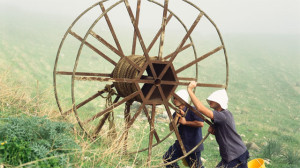In a compelling show at the Contemporary Jewish Museum, three artists present work that addresses conceptions of and attempts towards utopia. In very different visual languages, Elisheva Biernoff, Oded Hirsch, and Ohad Meromi stage interactive tableaux, captivating videos, and participatory sculptures, putting collective effort at the forefront of the exhibition. The idea of utopia is in constant flux, Work in Progress posits, and it is only through combined visions and repeated attempts at understanding that any true progress can be made.
The exhibition cleverly responds to both ‘progress’ (advancement toward a better state) and ‘in progress’ (in the course of being carried out). Several of the pieces are literally in progress, whether they are documentation of an ongoing film project or an interactive magnetic board open to visitor additions and rearrangements. Most importantly, the artists’ work doesn’t feel forced into what could be a heavy-handed or onerous theme. Biernoff, Hirsch, and Meromi all bring the viewer into their highly personal subject matter through the appealing aesthetics of their work and their ability to make small, individualized experiences take on broader implications.
Greeting viewers as they enter the exhibition are Meromi’s totem-like sculptures, elements of the installation 1967. A combination of natural and man-made materials in a variety of bright, playful colors makes the pieces irresistibly tactile. On just one I identified foam, a rubber mat, metal strips, and plastic tubes contrasted with unfinished and painted wood, all arranged in a pleasing conglomeration of balanced shapes. Any urge to touch these towers is alleviated by the large interactive stage that dominates the center of the exhibition.

Ohad Meromi, 1967Hanging beside the platform are a number of black fabric and wire costumes, meant to be worn by museum-goers and specially-trained museum staff. A takeaway poster shows sixteen posing figures on one side and a list of forty numbered phrases on the other. The list corresponds to a group of forty concrete panels ringing the stage that abstractly depict isolated daily narratives. Simple instructions encourage visitors to act out “armed youth,” “rejoice,” and “souvenir.” It’s easy to quickly relate the scenarios to life in a complicated and volatile land.
While the piece explicitly references border politics and periods of intense conflict, the dress-up/act-out staging is so playful and encouraging, Meromi succeeds at transforming the hard work of considering forty years of life in Israel into a thought-provoking game. Similarly, Oded Hirsch’s video and photo work marries levity with solemnity, drawing viewers into his absurdist wordless narratives with choreographed action and superb timing.




